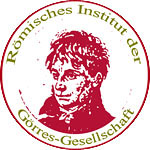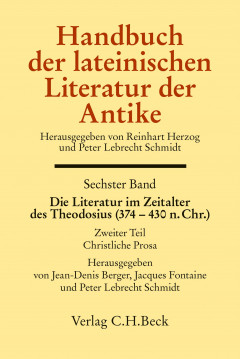Handbook of Patristic Literature - Jerome after all author of the Martyrology?
After 20, on the whole even 30 years of planning and work - with the transition from typewriter to PC! - the legendary Handbuch der Altertumswissenschaft published by Beck-Verlag has published the double volume 6,1-2 on the golden age of Latin patristics. When the volume was launched in 2020, 10 contributors had died in the meantime, including two of the three editors.
Even now, three years after publication, this book ad is still worthwhile. The two volumes with a total of 1,700 pages are a masterpiece in terms of editing and content, and accordingly still reasonably expensive at 148 and 178 euros. For an immense, almost boundless amount of material has been processed and edited here, and in a density that leaves the reader in awe.
The volumes are a literary history of Latin writing from 374 to 430 under the title "Literature in the Age of Theodosius" (which probably means Theodosius I, + 395). Thus, it is not a question of a substantive (possibly theological) examination of the writings in question, but of questions of authenticity, author, historical setting, occasion, dating and content, and above all of questions of the manuscripts and their transmission as well as the edition. The further impact of the work up to the Renaissance is also always addressed.
The double volume covers both pagan and Christian writings and surveys (almost) the entire spectrum of topics. In pagan writing, for example, law and administration, geography and topography, war and agriculture, land surveying, medicine and natural history, grammar and rhetoric are dealt with. Then comes poetry, including Christian poetry (Paulinus, Prudentius, etc.), and finally Rome as a cultural centre (rhetoric, philosophy, historiography, chronography, etc.).
The second volume comprises exclusively Christian prose, arranged by region: Rome/Italy, Northern Italy, Illyricum, Gaul, Spain and Africa. For the most part, therefore, it is a patristic literary history, arranged within the regions according to subject areas: Papal literature, Bible, apologetics, controversial literature (Luciferians, asceticism, Pelagians, Arians, Priscillians, Donatists, Manichaeans). Occasionally, the council literature is also taken into account; the second volume (Italian Councils) even begins with it.
Liturgy and homiletics do not play a role, but hagiography is widely considered in the second volume. Roman legends are treated, but also the hagiographical writings around Ambrose, as well as Gallic, Spanish and North African hagiography.
The structure of the handbook is remarkable, even unique. For a given late antique or early Christian scripture, the editions and the specialist literature are given first. This is still quite conventional. But then follow written-out "testimonies", i.e. Latin text sources that speak of the persons or the writing at issue. This makes it much easier to check the argumentation about the identification of the persons and writings. Subsequently, the content of the writing is summarised, linguistic peculiarities are promoted and the writing is classified in literary terms.
Jerome and his Martyrology
Two hagiographical texts are singled out, on which Peter Lebrecht Schmidt, one of the late editors of the handbook, makes highly remarkable assertions, some of which are completely out of line with the majority opinion of research.
It is claimed that a Roman list of martyrs from 399 (up to Pope Siricius), which was included in the Martyrologium Hieronymianum, contained the martyrs "in what was probably the original, greater completeness" (P. L. Schmidt, in: Vol. 6,2, p. 70). Accordingly, the more recent list of martyrs from 399 would be preferable to the older Depositio martyrum from 336. With this astonishing opinion, Schmidt follows none other than Mommsen and Duchesne (ibid. 150).
Even more sensational are the remarks on the Martyrologium Hieronymianum. P. L. Schmidt says that the two introductory letters of Bishops Chromatius of Aquileia, Heliodorus of Altino and Jerome have been "unfoundedly regarded as spurious" since the Renaissance (vol. 6,2, p. 151). With this he even revises the opinion of the Clavis Patrum Latinorum, which declares Hieron. ep. 48-49 to be "litterae ficticiae". For Schmidt, then, the oldest version of the Martyrologium Hieronymianum (completed in 399) is an authentic work of Jerome. This is remarkable insofar as then also the hagiographically highly significant lists of apostles with the missionary and veneration sites of the apostles, which follow the correspondence, are authentic and reflect a cult of the apostles around 399 (ibid. 152).
Schmidt then establishes a new stemma of the main manuscripts of the Martyrologium Hieronymianum. According to this, there are not 2, as claimed by de Rossi and Duchesne, but 3 families, namely Bernensis, Wissemburgensis and Epternacensis. All three go back independently to the archetype (vol. 6,2, p. 152). The best codex is now no longer E, but B.
- Details
- Written by: Stefan Heid
- Category: Recommended reading
 Römisches Institut der Görres-Gesellschaft
Römisches Institut der Görres-Gesellschaft







